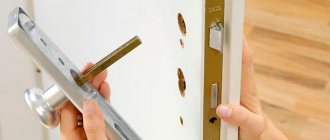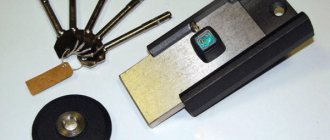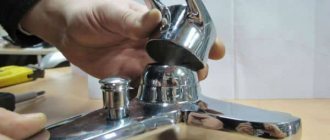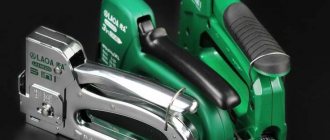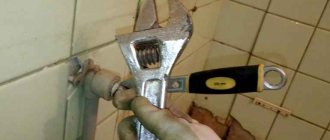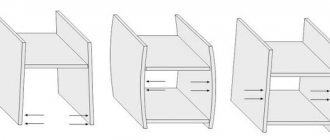Leaking plumbing is a problem that everyone has to deal with sooner or later: either the faucet is leaking in the kitchen, or a similar situation is observed in the bathroom. Be that as it may, remember: it’s not just water leaking, it’s your hard-earned money “running away” down the drain! How to fix a faucet if it's dripping? The solution to this problem depends on the type of plumbing fixture and the cause of the leak.
How to fix a faucet if it's dripping?
Let us immediately make a reservation that such a seemingly trivial problem can lead to the most tragic consequences - for example, the mixer may become completely unusable or water will burst at the most inopportune moment. Therefore, you need to act as early as possible. And it’s good that there is nothing extremely difficult here - find out the cause of the leak, acquire the necessary tools/materials and, in fact, start working.
How does a kitchen faucet work?
DIY faucet repair
What types of mixers are there?
Let's start with the fact that, depending on the design features, there are two groups of plumbing taps.
- Single lever. The water pressure and temperature in this case are regulated by just one knob, which rotates in two planes. Cartridges are used here as rotating mechanisms (they can be ball or disk).
How does a single lever mixer work? - Double lever (such devices are also called valve devices). Their distinctive feature is that the pressure is regulated by handles located on the sides of the mixer. Special valve axle boxes (they come with rotating ceramic plates or worm-type ones) serve as locking elements here. But we note that the service life of crane axle boxes is half that of the cartridges mentioned above.
Valve mixer
Important information! The repair process is largely determined by what type of dripping plumbing faucet it is. But we’ll talk about this in more detail a little later.
Possible leak locations
Long spout mixer
Features of ceramic taps
In addition to gaskets, a ceramic mixer contains a cartridge of two ceramic plates. In most cases it is necessary to change it.
In the cartridge of a single-lever mixer, the ceramic plates are fixed motionless relative to each other, and there is a microscopic gap between them - the mixing chamber. When the position of the cartridge changes, its inlet holes are differently aligned with the holes in the seat, through which cold and hot water flows, due to which the pressure is regulated.
Such a device is disassembled in several steps:
- Use a screwdriver or knife to pry off the red and blue plastic cap on the handle.
- Unscrew the screw located underneath it.
- After removing the handle, unscrew the clamping nut holding the cartridge and the rod.
- Remove the cartridge.
The two-valve ceramic faucet is disassembled, like its traditional counterpart - first the screw holding the wing is unscrewed, then the faucet-axle is removed. In this device, one of the cartridge plates rotates along with the wing, but the pressure is regulated in the same way - due to the coincidence of the holes.
Please note that commercially available cartridges may have slight differences, so you must go to the store with the original in hand.
Installation of a ceramic cartridge is carried out according to the “tongue and groove” principle, so you are unlikely to be able to install the “wrong” model: the protrusions on it simply will not fit the mounting holes in your mixer.
When assembling the single lever ceramic faucet, do not tighten the clamping nut too tightly. Otherwise, the adjustment lever will be difficult to turn.
A two-valve ceramic mixer may leak even if there is no damage to the cartridge plates. This means that they no longer press together tightly enough. This usually occurs due to deformation of the bottle cap-like silicone gasket that is supposed to support the bottom plate.
To correct the situation, a thin ring cut from technical rubber should be placed under this gasket.
Why might a faucet drip? Let's understand the reasons
As a rule, the cause of a leak can be easily determined by getting your bearings on the spot. Below are the most common causes of this problem.
Table. Why might a faucet drip? Common reasons
| Reason, photo | Short description |
| Poor installation of the device | If installation or assembly was carried out incorrectly, with errors, this will inevitably cause a leak (sooner or later). For example, if you tighten the nut very tightly during the process, this will damage the sealing gasket, which means it (the gasket) will wear out faster. A supply hose that is not secured tightly will cause a leak under the tap. |
| Ball cartridge clogged | The ball mixer has a by no means ideal design - the internal parts, which fit very tightly, react poorly to various types of impurities in the liquid. To eliminate a leak in this case, the faucet will have to be completely disassembled and thoroughly cleaned. |
| The oil seal is worn out | The main disadvantage of the oil seal (or, as it is also called, the oil seal) is that it wears out very quickly. This problem is easy to identify: if the tap is closed, then there are no signs of a malfunction, but if it is opened, water will immediately begin to flow from under the valves. This suggests that the reason lies in the wear of the oil seal. |
| Faucet wear | Any plumbing equipment has a limited service life, therefore, over time, users encounter problems such as wear of the threads or locking mechanism. In such a situation, nothing can be achieved by replacing individual parts or tightening the nuts - it is necessary to change the entire mixer. |
| Wear of the rubber gasket | Repeatedly turning the faucet on/off leads to wear of its elements (including the gasket). The material deforms, its dimensions change, and cracks appear on it. And if your faucet drips in the closed position, then the problem most likely lies in the gasket (it needs to be replaced). |
Leak between faucet and sink
Causes
Let's figure out why water drips from the mixer tap.
As a rule, it is not possible to completely shut off the water in the mixer due to excessive wear of the gaskets installed in it or the mixing unit.
This phenomenon is due to natural causes and cannot be avoided.
In order for the parts to last longer, the mixer must be used carefully, without applying too much force. This is especially true for valve devices with a screw stem, in which, when the valve is tightly tightened, the gasket quickly wears out and breaks.
Leaks can also be caused by damage to certain elements. They are primarily caused by solid impurities present in the water. These are small fragments of scale, scale, rust or sand. In devices with ceramics, such particles can cause chips and cracks on its surface. These mixers are especially demanding on water quality, so before installing them, the water supply system must be equipped with mesh filters (they are also called oblique filters or mud filters).
For mixers with screw stems, solid particles are not a damaging factor, except in cases where one of them is caught between the gasket and the seat. Such an accident leads to both deformation of the gasket and the appearance of scratches on the seat, as a result of which leaks will certainly appear.
How to fix a leaking faucet
Let’s say right away that in most cases there are no difficulties in replacing a leaking faucet, but beginners still often encounter some problems. However, preliminary preparation and strict adherence to step-by-step instructions will help cope with leaks and significantly increase the service life of the mixer.
In principle, repairing a faucet yourself is not such a difficult task.
Leaking at the faucet mounting point
It may leak here due to worn-out gaskets or if there are defects on the body (microcracks, broken threads). Replacing the gasket couldn't be easier.
Check it out here too!
Homemade lanterns with your own hands: step-by-step instructions on how to make a beautiful and effective lantern (110 photos)Grout - use, reviews, leading manufacturers
Replacing a pressure tap - a step-by-step description of how to change a pressure tap with your own hands (80 photos + video)
First, the fastening union nuts are unscrewed, then the old rubber is removed and replaced with a new one. Reassemble in reverse order. But if there are defects at the mounting points, then you just need to replace the mixer itself or the pipes.
Preparing for work
Before you begin directly repairing/replacing the mixer, you must turn off the water in the riser. Otherwise, problems with the tap will be aggravated by flooding of the apartment (not only your own, but also the neighbors below). Only after turning off the water can further work begin.
Water supply risers
To carry out repair work, you will need the following:
- some kind of vessel (to collect water);
- rags;
- Adjustable wrench;
- sponge;
- silicone seals;
- cleaning agent;
- screwdrivers;
- wrench;
- fluoroplastic sealing tape;
- rubber gaskets (new);
- pliers.
Fluoroplastic tape
All these tools/materials are quite enough to deal with a leaking plumbing faucet with your own hands.
On a note! If the mixer was purchased recently and you even saved the packaging, then you may find the manufacturer’s instructions and even a repair kit in it. In this case, the work will go much faster.
Repair kit for mixer (AKVAREM)
Water dripping from the gander
The first time the problem of water dripping from a spout is identified most often at night, when in complete silence the rhythmic sound of a drop falling prevents household members from falling asleep. There is no point in delaying repairs in such cases, because they are quick and easy. In most of these cases, the causes of leakage are worn gaskets or cartridges.
Repair of valve body
You need to start replacing the valve control head by turning off the water in the house. The problem of leaking faucets with valve heads is a defect or wear of the gasket adjacent to the seat of the mixer body. To replace it, it is necessary to carry out a series of sequential actions.
First. Unscrew and remove the valve body. Typically, the flywheel is secured with a bolt hidden under a decorative cap. You can pry off the cap that hides the bolt using a small flat-head screwdriver or an ordinary awl.
The valve body should be easy to remove; try not to damage its outer covering, especially when prying off the decorative cap with a screwdriver or awl
Second. Unscrew the head itself with an open-end wrench.
The edges of cheap Chinese sockets lick off very easily, so it is advisable to unscrew them with well-fitting open-end or ring wrenches
Third . It is necessary to remove the old worn rubber gasket and install a new one. An elastic band costs a penny, but it will provide several years of peace of mind to your nerves. And if you have a choice, you need to buy products from more reliable manufacturers.
Before installing the gasket, it is necessary to check its lower surface for smoothness and, if there are defects, cut off the protruding parts. It is better to cut a small chamfer along the circumference from the bottom side so that the gasket is pressed more tightly to the seat and the faucet does not hum
Fourth. Dry and scrub the seat on the faucet body with a steel wool or other abrasive material, and then wipe it clean.
Fifth. Screw the head into place and close the valve with a decorative housing.
After the above steps, you can make sure that the faucet is not leaking and the unnerving rhythmic dripping of water into the sink has disappeared.
Photo instructions for replacing the gasket
In valves with a rod locking mechanism, by analogy with valve devices, the most wearing part is the rubber gasket. And although such devices are now difficult to find in urban environments, they are still actively used in dachas.
It is worth familiarizing yourself with the sequence of work for replacing the valve seal that blocks the flow of water:
Image gallery
Photo from
Step 1: Removing the Crane Operating Mechanism
Step 2: Examine the O-ring
Removing the Valve Stem Gasket
Step 4: Gasket Replacement and Reassembly
Repair of a hinged mixer
Articulated (single-lever) faucets have become widespread because of their ergonomics: you do not need to turn the valves for a long time, smearing them with grease and flour in the kitchen. Despite the external simplicity and elegance of the forms of such cranes, the algorithm for their operation is quite complex.
To increase the level of maintainability of articulated faucets, manufacturers began to use a modular type of design: a special cartridge is installed inside the body, containing all the necessary mechanical filling.
Therefore, special knowledge is not required to understand how to fix a leak in a swivel valve: in case of most breakdowns, the entire cartridge is replaced.
Water leaking when the tap is closed implies a violation of the seal between the seat and the plastic or ceramic regulatory parts of the cartridge. You can try to disassemble and clean some models, but the likelihood of returning the cartridges to functionality and eliminating leaks is very low. To quickly replace the internal filling of the swivel valve, do the following.
First. Remove the decorative colored cap. It serves not only to cover the bolt, but also indicates the position of the lever when supplying cold and warm water.
Remember the correct position of the cap so that you can return it to its place in the future - this will prevent people from being confused about turning on warm or cold water
Second. In the opened hole, you need to unscrew the fixing bolt that secures the lever to the cartridge.
Unscrew the bolt with a suitable screwdriver: if the grooves on the head “stick together”, then there is a high probability that the lever will need to be sawed and replaced
Remove the faucet handle.
The removed lever can be cleaned using this moment. To do this, it is recommended to use a cleaning agent without abrasive or scratching particles.
Third. The cartridge is closed with a decorative cap, which must be unscrewed by hand. Under the cover there is a large circular nut, which poses the main problem for those who want to change the cartridge themselves.
To unscrew this nut, you need an adjustable wrench with a gap of 27-32 mm. Not every owner has such keys in the utility room, so you need to worry about their availability in advance.
When disassembling the faucet locking mechanism, remember in what order the parts were removed in order to install them back in the same order
For convenience, it is better to lay out the removed parts on a flat surface in this order. It is advisable to photograph the disassembly process so as not to get confused in the details during reassembly.
The circle nut is very narrow, so old Soviet wrenches with smoothed edges are often unable to unscrew it. It is recommended to use modern keys with clear edges to remove it.
Fourth. After unscrewing the nut, the cartridge is pulled out and replaced with a similar new one.
The old cartridge can be saved in case its new counterpart turns out to be defective or quickly breaks down, because a leaky faucet is better than no faucet at all
If you have saved the packaging from the old faucet, then you can use it in the store to buy a suitable cartridge model in advance. If the type of mixer is unknown, then you will have to repair the faucet in the morning or afternoon, so that after disassembling it you can have time to go to the store and buy a similar part.
The cartridge has special protrusions on the lower half that correspond to the dimples on the seat. They are needed to fix the parts in a clearly defined position.
The guide protrusions on the cartridge are necessary not so much for the correct location of the holes, but for precise alignment of the location of the sealing gum
After installing the cartridge, the faucet components are assembled in the reverse order.
If the cause of water leakage is microcracks or grooves in the seat, you can try sanding the metal surrounding the hole with a drill with a small grinding head. Large cracks cannot be repaired and are a clear sign that you need to buy a new faucet.
You can find out more about how to repair a ball mixer in our article.
Method No. 1. Replacing the gasket
If the rubber gasket needs to be replaced, you need to proceed according to the following algorithm.
Step 1. First, the valve is disassembled - the plug is removed, then the screw located under it is unscrewed and the core is unscrewed using an adjustable wrench (you need to turn it counterclockwise) to remove the valve axle box.
Replacing the gasket in the valve mixer
Step 2. The gasket must be replaced and secured in the axle box.
Step 3. At the end of the removal, all the elements are installed in their places.
Prices for bathroom faucets
bathroom faucet
Step-by-step process for replacing the gasket
Valve mixer leak elimination diagram
Note! If the faucet is leaking in the shower, then using the same adjustable wrench you need to unscrew the shower hose, replace the gasket, and then fasten it (the hose) in place. The gasket under the gander nut is also changed.
Unscrewed hose
Mixer body leaking
Selection and operation of a kitchen faucet
Breakdowns in the plumbing system occur with enviable regularity, and the reason for this may be the lack of proper regular maintenance. And above all, monitoring the operation of the water supply system is important.
The system operates stably only at stable pressure; sudden changes destroy it, and the sealing gaskets and threaded connections of locking devices are the first to suffer.
which faucet mixer to choose for the kitchen
The initial quality of the tap is of great importance. First of all - the material of manufacture. A good faucet or mixer is made of heavy alloys - brass or bronze, they are easy and simple to fix. Materials such as silumin are absolutely unsuitable for plumbing, although they are often used by unscrupulous manufacturers.
Single-lever devices are convenient to use and can be operated with one hand. You should avoid purchasing products from manufacturers in China and Turkey - they traditionally do not differ in quality and durability and begin to leak immediately after installation.
Method No. 2. Replacing the stuffing box seal
If the cause of a leaking plumbing faucet is wear of the seal, then you can fix the problem in one of two ways:
- unscrew the stuffing box nut, and then replace the stuffing box itself;
- make the liner yourself from fluoroplastic tape.
Another solution to the issue is to change the oil seal or the entire faucet.
If you do everything correctly and in accordance with our recommendations, the faucet will stop dripping and the valve will turn smoothly.
Video - How to repair a faucet
Leak at the base of the valve
The flywheel, also known as a valve, is designed to regulate the flow of water through the spout tube. The adjusting head (faucet axle) is usually attached to the faucet body with a threaded connection and contains one or more o-rings to seal the internal area of the mixer.
Below are two diagrams of valve mixer locking devices in comparison with a single-lever faucet (right).
Between the head body and the rod there may be o-rings, bushings, sealing lubricants, which in most cases cannot be replaced
The flywheels are covered with decorative casings, which are attached to the heads with a screw or bolt hidden under a small cap.
Causes of valve leakage
The adjusting head has a complex internal structure.
Between the head body and the rod there may be o-rings, bushings, sealing lubricants, which in most cases cannot be replaced
Water may leak from under the valve casing due to the following breakdowns:
- Insufficient level of head sealing:
- the faucet axle is not pressed sufficiently against the mixer body (in modern models);
- poor-quality winding of the thread when screwing in the head (in older models of taps without o-rings).
- Damaged rubber gaskets or rings between the mixer body and the faucet axle box.
- Aged stuffing box packing of the rod. With this breakdown, an increase in leakage is observed when the tap is open.
Before diagnosing the causes of valve leakage, it is necessary to shut off the general water supply in the apartment and remove the decorative covers from the flywheel.
You should not use strong forces when disassembling the mixer without first studying the method of attaching the flywheel and the locking mechanism: you can break the tap
After gaining access to the adjusting head, you should open the water and determine the places where water is oozing. Then turn off the water again and begin repairs.
Troubleshooting Methods
It is necessary to consider methods for repairing the valve mechanism, taking into account the location of the water leak.
Option one : water flows from under the stem.
If the crane has a non-separable adjusting head, then there is only one way out: buy and install a new crane axle box, there is no other option. However, most reputable faucet manufacturers usually include repairable heads in their products. If they have an oil seal bushing on top, you can try to tighten it with a wrench and check for leaks.
If water leaks with the stuffing box clamped as tightly as possible, you can disassemble the head, remove the seal and try to replace it. The adjusting valve axle boxes in most mixers are standardized, but it is not always possible to find a new oil seal of the required design on sale.
If it is impossible to repair a leaking head by replacing the oil seal, then it should be replaced with a new one.
Option two: water flows out at the junction of the mixer head and body.
The simplest way to solve this problem is to press the head against the mixer body with a wrench. If the result of this action is negative, you need to unscrew the valve axle and check the sealing gaskets.
It is possible that during the initial installation of the faucet they moved to the side or twisted, which eventually caused a leak. It is recommended to remove and reinstall the O-rings and then screw the adjusting knob back into the faucet.
The sealing ring must not be twisted. Be sure to check its position after it is finally placed on the faucet head.
If reinstalling the sealing gaskets does not lead to the disappearance of the leakage, then their complete replacement is required.
Instead of rubber seals in Soviet taps, tow with paint was often wrapped around the threads. If there is a leak from under the valve in such mixers, you must first completely clean the head of any remaining sealant, and then wrap a convenient fum tape or the same tow lubricated with silicone around the threads.
After this, you should tightly screw the head back into the tap and rejoice at the absence of leakage!
Another reason for a leak in the gap between the valve and the faucet may be the appearance of a small groove or scratch along the edge of the mixer body under the adjusting head gasket. If such defects are found, then you should carefully sand the entire annular surface until the scratch disappears, and then reinstall the valve axle.
If, due to serious defects in the faucet elements, it is impossible to stop the leak using the methods described above, then you need to prepare the family budget for the purchase of a new faucet. We advise home craftsmen to study the technology of installing a faucet on the side of a sink in the bathroom or kitchen.
Method number 3. Ball valve repair
If the problem lies in the ball valve itself, then it must be disassembled and thoroughly cleaned, and, if necessary, the locking mechanism must be completely replaced. In this situation, you should act this way.
Schematic structure of a ball model of a kitchen faucet
Step 1. First, unscrew the screw and remove the lever.
Step 2. Then the threaded screw is unscrewed.
Step 3. The mixer dome is removed (along with its plastic part).
Step 4. The ball is removed and carefully inspected. If any defects or damage are detected, the ball must be replaced.
Step 5. The seals are removed and checked for wear and whether there is plaque on them.
Step 6. Dirt and deposits are removed from the seals, after which a special lubricant is applied.
Ball mixer disassembly diagram
Step 7. All parts are installed back. Connections are checked for leaks.
Touchless faucet with motion sensor
If the mixer is assembled correctly, there should be no leaks; the water temperature will be regulated by light turns of the lever.
Stages of installing faucets in bathrooms
Method number 4. Replacing the cartridge
We have already mentioned above that cartridges are more convenient to use than axle-box cranes, but if they break, then, alas, the entire mechanism will have to be replaced at once. Below is an algorithm of necessary actions.
Changing the cartridge
Step 1. First of all, unscrew the plug on the lever, after which the fixing screw is also unscrewed.
Step 2. Decorative elements are removed, then the nut that presses the cartridge is unscrewed.
Step 3. The mechanism is removed and carefully inspected (you need to find out what the condition of the gaskets at its end is). Note that they can be replaced.
Prices for kitchen faucets
kitchen faucet
How to remove a cartridge
Step 4. If it is impossible to replace the seals, a new disk element is inserted into the tap.
Step 5. All elements of the crane are put back together.
Scheme for self-installation of the cartridge in the mixer
Other leaks independent of the type of structure
After we have studied how to replace the shut-off elements of various types of faucets, we will consider other reasons why a bathroom faucet leaks, regardless of its design.
Malfunction or leakage of the switch from the gander to the shower
Bathroom faucets have a switch that allows you to redirect the flow of water from the gander to the flexible shower hose and vice versa. The most common breakdown of such switches is that water flows from both the gander and the shower at the same time. Most often there are two types of switches:
- Flag or pendulum type. Installed on valve mixers.
Mixer with flag type switch. - Push-button or pull-out type. Most often they are installed in the body of cartridge valves, but can also be mounted on valve devices.
Push-button switch.
Let's look at how to repair these types of switches.
Replacing the pendulum switch
The rotary switch is a brass valve or cartridge, which is replaced with a new one in the same way as a faucet:
- The decorative plug on the lever is picked out, allowing access to the screw.
- The screw is unscrewed and the lever is removed.
- Use a key of suitable diameter to unscrew the switch.
- A new spool is screwed in, the lever is put on and fixed.
Button switch repair
In this design, the most vulnerable element is the gasket, which is subject to wear, deformation and hardening, due to which it no longer holds water. If the button no longer redirects the flow of water, it is necessary to replace the gasket, which is done in the following sequence:
- The button is unscrewed with an adjustable wrench. It must be removed from the case carefully so as not to damage other structural elements.
- There are rubber sealing washers on the metal rod - they need to be replaced with new ones.
- After changing the gaskets, the button is inserted into the housing and screwed in.
Note! Another breakdown of the push-button switch is jamming in the raised (upper) state, as a result of which water flows only through the shower. Such a malfunction means that the spring that returns the rod to its original position has become unusable. This part cannot be replaced, so the switch is replaced completely.
Leak at the connection point of the gooseneck to the mixer body
One of the common places for leaks is the connection between the gander and the mixer. This connection is sealed with a ring made of dense rubber, which is placed on the body of the gander. When turning the gooseneck, the gasket gradually wears out and a leak forms. To eliminate this problem, you need to replace the gooseneck O-ring. This is done in this order:
- Use an adjustable wrench or Swedish screws to unscrew the gander fastening nut.
To replace the gasket on the gooseneck, you need to unscrew the mounting nut. - The worn gasket is picked out and a new one is installed in the groove. It is convenient to do this with tweezers, since the fastening nut is non-removable and remains in place.
- After changing the gasket, the gooseneck is put in place and the nut is tightened.
Advice! In order for the gib with the new ring seal to easily fit into the mixer body, the ring must be lightly lubricated with silicone grease or sealant, which will ensure easy sliding.
Leak at the connection point of the shower hose and shower head
Even during the operation of the mixer, leaks often form at the connection points of the flexible hose to the mixer and shower head. Gaskets are installed in these places, which become deformed and fall in over time. If a leak occurs, disconnect the hose and replace the gaskets.
The hose is connected to the mixer using a hex nut. You need to unscrew it and change the gasket.
To replace the gasket where the shower hose connects to the faucet, you will need a wrench.
The connection between the hose and the shower head is made using a conical relief nut, which can be unscrewed without a tool and even a girl can do it. There is a gasket on the pressure hose that needs to be replaced with a new one.
Note! The hex and flare nuts for connecting the shower hose are very thin, so you should not use much force when tightening them, as they may burst.
Leaks where the faucet connects to the water supply
There are situations when the tap begins to leak at the points of connection to the water supply. The procedure for eliminating a leak depends on the installation location and the method of connecting the mixer.
Leakage at the junction of supply pipes
The cause of leakage at the connection point of the wall-mounted mixer at the connection points to the pipes coming out of the wall is the sealing or misalignment of the gasket. To eliminate this malfunction, you need to unscrew the fixing nuts, disconnect the mixer and replace the gaskets with new ones.
Leakage of supply flexible hoses
Faucets installed on the side of a bathtub or sink are connected to the water supply using flexible hoses. The formation of a leak at the connection point is the result of wear or chafing of the seals placed on the thinned end of the hose.
The O-rings on the thin end of the hose can wear out, causing a leak.
To replace the rings, you need to remove the faucet from the sink, since doing this from the bottom of the plumbing fixture is difficult and sometimes impossible. Having removed the mixer, unscrew the hoses one by one with a wrench, replace the rubber rings on them, after which all the elements are installed in place.
To replace the O-rings on the flexible hose, you need to dismantle the mixer.
If the water pressure drops
There are situations when the water pressure in one of the taps decreases significantly. The reason for this problem is an aerator clogged with scale and other debris - a mesh filter screwed into the end of the gander. To fix this problem, just unscrew the aerator, rinse with water and clean the filter mesh with a needle or thin awl, and then screw it into place.
A clogged strainer is the cause of reduced water pressure.
The considered malfunctions and methods for eliminating various leaks will allow you to repair faucets yourself without calling a plumber. As practice shows, many types of leaks and breakdowns can be avoided if you take good care of your plumbing. The quality of mixers and the degree of mechanical purification of water also play an important role, so installing coarse and fine filters is sometimes simply necessary.
Advice! If you need bathroom renovation specialists, there is a very convenient service for selecting specialists from PROFI.RU. Just fill out the order details, the experts will respond and you can choose who to collaborate with. Each specialist in the system has a rating, reviews and examples of work, which will help with the choice. Looks like a mini tender. Placing an application is FREE and does not oblige you to anything. Works in almost all cities of Russia.
If you are a master, follow this link, register in the system and be able to accept orders.
What to do if the new faucet is dripping?
Sometimes even a faucet that was purchased and installed relatively recently begins to leak. In such situations, the reason, as a rule, is simple to the point of banality - the device has a manufacturing defect, which is difficult to identify during external inspection.
Important information! Cracks and chips inside the structure can hardly be eliminated on your own - even an experienced plumber will not be able to do this. That is why the only correct solution is to return the faucet to the store and ask the seller to replace the defective model.
New faucet
Finally, we note that the faucet in the kitchen or bathroom can start dripping at any moment. To solve this kind of problem, you can go one of two possible ways - to involve a qualified specialist in the work or to try to do everything yourself. However, if you know the exact cause of the leak and how to properly eliminate it, then no difficulties should arise.
Note! To prevent a leak from appearing at the most inopportune moment, regularly carry out preventive measures - change gaskets in a timely manner, check the condition of locking mechanisms. All this will significantly extend the life of the crane!
Briefly about the main thing
In order to know how to fix a faucet if it drips, you should first determine which faucet is installed, as well as how it is designed, since valve and single-lever devices differ in design and type of locking mechanism.
You can easily repair a faucet yourself if you have the necessary knowledge and tools. Most often, a leak is the result of wear on the gasket or deformation of the shut-off device.
To keep the faucet in working condition, it is necessary to carry out professional maintenance every two years.
Ratings 0
Repair tools and materials
repair kit
on hand :
- rubber gasket for the gander, which wears out with regular turning;
- retaining ring for sealing the water shut-off unit;
- valve head seal (2 pcs.);
- locking gasket - a rubber cuff for the valve axle;
- valve head washer;
- lining for check valve;
- eccentric gasket.
For repairs you will need tools:
- a set of wrenches or one adjustable wrench with movable jaws;
- flat and Phillips screwdrivers;
- electric drill, knife, hammer, pliers.
The materials needed are different for each individual repair case.
THE FAUCET IS LEAKING IN THE KITCHEN - HOW TO FIX IT YOURSELF
To repair a kitchen faucet you will need:
- knife with a sharp end;
- hex and adjustable wrench;
- screwdrivers;
- a new cartridge, valve axle, rubber gasket, etc. - depends on which part you will change;
- WD40 is a technical aerosol that is useful if parts are “stuck” to each other. However, you can get by with the traditional tapping of a hammer on a screwdriver, but there is a high risk of damaging the mixer.
Regardless of which faucet you have installed, before starting repairs, you must turn off the water supply to the system and drain its remaining water into a sink or a separate container. To do this, just open the tap. Then you can begin to repair it, taking into account the design features.
To repair a single-lever faucet, you will need a hex wrench.
REPAIR OF SINGLE LEVER KITCHEN MIXER
The main principles of repair are sequence of actions and accuracy.
- Using a thin screwdriver or knife, pry and remove the decorative plug on the faucet body.
- In the resulting hole you will see a screw connecting the lever and the adjusting rod. Unscrew it using a hex wrench.
- Remove the lever from the body and unscrew the decorative casing. This can even be done by hand if the parts are not stuck to each other.
Removing the decorative casing
- There will be a locking (clamping) nut underneath it. Gently unscrew it with an adjustable wrench or by tapping it with a hammer on a screwdriver.
- If you disassemble the ball mixer, you will see a sealing collar under the nut. Inspect it for dirt, deformation and tears. Pull out the ball. Inspect its surface - it should be smooth and clean. It is necessary to remove the seals and support springs - their poor condition can cause the tap to leak.
- If you are disassembling a faucet with a cartridge, remove it and thoroughly inspect it.
- Replace the failed part.
- Reassemble the faucet in reverse order.
Installing a new cartridge
To extend the service life of the product and ensure smooth running of its rubbing parts, you can use a special silicone lubricant.
Removing the mixer handwheel
REPAIR OF TWO-VALVE MIXER
What to do if your two-valve faucet is dripping in your kitchen? Almost everything is the same.
- On the valve flywheel, pry up and remove the decorative plug.
- Using a screwdriver, unscrew the screw that secures the flywheel.
- Remove the flywheel. There will be a crane box in front of you.
- Unscrew it counterclockwise and inspect it.
Removing the crane axle box
- If it is a worm-type axlebox and its gasket is damaged, replace it separately - buy it in a store (costs pennies) or cut it yourself from rubber of a suitable thickness. The axle box with ceramic discs is replaced entirely.
- Reassemble the faucet in reverse order.
General scheme of mixer repair work
Everything is as simple as possible and slightly reminiscent of a construction set. But a leaking faucet is not the only problem you may encounter while using it in the kitchen.
Leak prevention
Be sure to install cleaning filters or an entire system at the entrance of water pipes to the house. The measure will protect against insoluble impurities in the form of rusty particles and reduce water hardness.
Buy mixers from well-known manufacturers . They are responsible for quality and provide certain warranty periods for products. Enterprises have production control at every stage.
Experts recommend changing gaskets at all known faucet joints every 2–3 years to prevent damage to more significant and expensive parts. You need to use the levers carefully, tighten the valves all the way, but do not pinch them - this will extend the operating time of the rubber gaskets.
What is a mixing diverter?
It is extremely simple to answer the question of what a diverter is in a mixer. This is a regular switch that redirects the flow of water. The mechanism is quite simple, but due to the presence of parts in the design that rub against each other and their direct contact with water, the product (of particularly low quality) quickly fails. Diverters differ:
Type
There are switches for the shower and kitchen sink spout. Consumers have been familiar with the first type of product for a very long time. It can be push-button (press/release position) or lever (up/down position). Almost all faucets with a hygienic shower head are equipped with mechanisms of the first type. For example: a new model of sanitary equipment from IDDIS Urban URBSBL2i10. By moving the diverter on the mixer to the upper position, the user turns on the hygienic shower, lowering the tap down.
The second type of switches appeared relatively recently. They are equipped with kitchen sink faucets, which provide for the use of water filters or dishwashers. The principle of operation is the same for all.
Functionality
Two-position and three-position spout diverters are used. The first type is classic. The second has an additional option and is often used exclusively on kitchen faucets when it is necessary to provide water supply in 2 directions. The price of 3-position models is higher - from 950 rubles.
Parameters
There are diverters for faucets with ½ and ¾ inch threads. When choosing a spare part, this technical parameter must be taken into account.
Manufacturing materials
Brass switches are considered affordable. Their body and internal components are covered with a protective coating - chrome, nickel (now extremely rarely used), enamel, ceramics, zinc, copper. Each diverter coating option has its own advantages and disadvantages. For example: chromium provides high hygienic qualities, enamel is durable, but is susceptible to mechanical stress, and nickel can cause allergies. Not long ago, consumers were offered a ceramic diverter for the mixer (not the entire mechanism, but only functional plates) and devices made from the innovative POM polymer. The price of switches is 30-45% higher than classic models, but so is their service life.
External data
Since the diverter is an integral part of the faucet design, its design matches the appearance of the faucet. It is recommended to replace it with a switch of the corresponding data and color scheme. According to consumers, the largest selection of diverters by style is offered by Kaiser (Germany). For example: a minimalist chrome-plated rotary mechanism with a ¾-inch thread. The price of the mechanism is from 680 rubles.
If your faucet diverter fails, you can buy a model from any manufacturer, the main thing is that it matches the technical parameters of the plumbing equipment.
This is interesting: Blanco mixer - models Mida and Fontas, Sora and Trima chrome, Daras Silgranit and Klea, product reviews
How to repair a single lever faucet if leaks are detected
Typically, a leak of this kind occurs as a result of a cartridge failure. This element has the form of a compound cylinder, with three holes located at the bottom. One of them is designed to flow out cold water, the second - hot water, and through the third, mixed warm water flows.
Replacing the cartridge in the mixer
Depending on the mechanism used to mix cold water with hot water, cartridges are divided into two types: ceramic and ball. At the top of the cartridge there is a rod with the lever of the mixer itself attached to it. This is where the leak occurs.
What are the signs to determine when it’s time to replace the faucet cartridge?
The main ones are:
- no supply of cold or hot water;
- the water spontaneously becomes either hot or cold, without using a lever;
- the tap does not close completely or does not function normally;
- when switching the lever, you need to make quite a significant effort;
- presence of leakage from under the lever.
Shower switch repair
There are several types of shower switches, let's look at some of them.
Spool
The leak in such switches comes from under the handle that opens and closes the water supply.
Causes of malfunction:
- Are the rubber rings on the rotary rod working or not,
- the gasket on the axle box is worn out,
- The axle box is twisted.
After correcting or replacing parts, the switch must be assembled and tested. Don't forget about lubrication of the switching mechanism.
Button
To disassemble this mechanism, you need to turn off the tap, remove the cap, unscrew the screw and pull out the button with the spring.
Reasons for failure:
- the spring has sagged and does not hold,
- Valve rings are worn.
If the spring has sagged, you should replace it with a new one or make it yourself. To do this, it is stretched and heated red-hot, after which it is dipped in cold water. After cooling, you need to heat it again for uniform hardening. You can also make a wire spring using the same method.
If the valve rings become brittle, they should be replaced. After replacement, the entire mechanism must be lubricated with Vaseline or another lubricant.
Suberic
The main problem is that the plug does not fit well to the body and leaks. It could also be:
- poor rubbing,
- mechanism erosion,
- presence of solid particles in the housing.
In order to fix such a switch, you need to unscrew the screw, remove the handle, unscrew the nut and remove the locking ring. After a thorough inspection, the parts should be lubricated with Vaseline and assembled into place.
